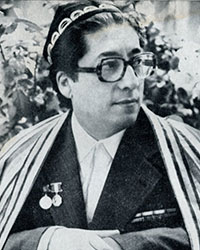SHARE WITH FRIENDS:
 Mirmukhsin (Mirsaidov), one of the most prominent representatives of Uzbek poetry and prose, was born on May 1921, 3 in the Kurgantepa district of Tashkent in a family of potters. After graduating from high school in 1933 he entered the Tashkent State Pedagogical Institute named after Nizami. After graduation (1941), he served in school education, leading newspapers and magazines in the Republic, radio. In particular, he worked as the editor-in-chief of Sharq Yulduzi magazine for twenty years and Mushtum magazine for almost ten years.
Mirmukhsin (Mirsaidov), one of the most prominent representatives of Uzbek poetry and prose, was born on May 1921, 3 in the Kurgantepa district of Tashkent in a family of potters. After graduating from high school in 1933 he entered the Tashkent State Pedagogical Institute named after Nizami. After graduation (1941), he served in school education, leading newspapers and magazines in the Republic, radio. In particular, he worked as the editor-in-chief of Sharq Yulduzi magazine for twenty years and Mushtum magazine for almost ten years.
The author's work dates back to the 30s, when he first published collections of poems and short stories, such as "Sherali's Courage" and "Hunter Children" (1936). His seminal epic Kamar, created in 1939, later served as a bridge in the transition to the major epic genre.
During World War II and the post-war years, Mirmukhsin's work became increasingly multifaceted and serum. He wrote poems depicting the heroism of the Uzbek people on the battlefields during the war. His collections "Er Yurak" (1942) and "Vatan" (1942) are characteristic in this respect.
Mirmukhsin was also known as a dostonnavis. He published a number of epics, including "Master Giyas", "Donan" (1947), "Green Village", "Dear" (1954), "Shirak" and "Nevara". In these epics, the image of contemporaries was created, and such qualities as diligence, patriotism and spiritual integrity were glorified. Having gained great experience in the genre of epics, the poet wrote the poetic novel "Ziyod and Adiba" in 1958. From the same period, the writer also tended to prose genres. Her books of prose were published, such as "Dorbozlar" (1956), "Jamila" (1957), "Hikoyalar" (1959), "Kizil durralar" (1961), "Sozanda" (1963). His short stories, such as "White Marble" (1958), "The Maid" (1959), and "Night Lightning", showed that the writer was not only a mature poet, but also a skilled prose writer. In particular, his series of stories and narratives dedicated to the Arab world showed that the writer’s prose talent has great potential. Mirmukhsin later wrote the international story “Chodrali.
Mirmukhsin was also a prolific novelist. His historical epic paintings "The Architect" (1974), "Temur Malik", "Queen of Turan" (1997) have won the recognition of the literary community. Mirmukhsin has also written a number of novels on contemporary topics. His novels "Hope" (1969), "Exercise" (1970), "Son of Degrez" (1972), "Chatkal tiger", "Roots and leaves", "Snake's eye" (1995) tell the story of time and contemporaries. In particular, the author's novel "Hope" caused a heated debate in his time. In it, the fate, happiness and tragedy of young people are clearly expressed.
So, Mirmukhsin is a poet, epic writer, storyteller, storyteller, novelist, children's poet, journalist, author of more than three hundred works. Many of his works have been published in Russian, Ukrainian, Kazakh, English, Kyrgyz, Arabic and other languages. Mirmukhsin's rich and diverse work is highly valued by the people. In 1974, he was awarded the Hamza Republican State Prize for his novel Umid. At the same time, he is an outstanding public educator of the Republic, Honored Worker of Culture of the Republic, People's Writer of Uzbekistan (1981). He was awarded the Order of "El-Yurt Hurmati" (1998). The writer died in 2005 in Tashkent.